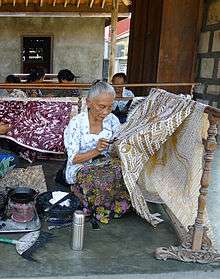Canting
.jpg)
Canting (Javanese: canthing, IPA:tʃanʈiŋ, sometimes spelled with old Dutch orthography tjanting) is a pen-like tool used to apply liquid hot wax (Javanese: malam) in the batik-making process, more precisely batik tulis (lit. "written batik"). Traditional canting consists of copper wax-container with small pipe spout and bamboo handle. Traditional canting is made of copper, bronze, zinc or iron material, however modern version might uses teflon.
Design
.jpg)
A canting consists of:
- Nyamplung: a rounded liquid wax container, made from copper.
- Cucuk (IPA:tʃutʃuk): a small copper pipe or spout that connects to nyamplung container, it is where the liquid wax comes out to be applied to the cloth.
- Gagang: canting holder, usually made from bamboo or wood.
The size of canting may be vary according to the desired dot size or line thickness to be applied upon the cloth. The batik craftsperson use canting in similar fashion as drawing using pen.
History
G. P. Rouffaer reported that the gringsing batik pattern was already known by the 12th century in Kediri, East Java. He concluded that this delicate pattern could only be created by the canting, an etching tool that holds a small reservoir of hot wax. He proposed that the canting was invented in Java around that time.[1]
Technique

Firstly, the cloth must be washed, soaked and beaten with a large mallet. The hot and liquid wax is scooped from small wajan (wok) heated upon small stove. The batik craftperson sometimes blow the spout tip of canting to allow the liquid wax to flow smoothly and to avoid clogging, then they draw the line or dot upon the cloth, applying the liquid wax, following the patterns and images that previously had been drawn using pencil.[2] A pattern is then drawn with hot wax called malam using canting. The wax functions as a dye-resist. After this, the cloth is dipped in a dye bath containing the first colour. After the cloth is dry, the wax is removed by scraping or boiling the cloth. This process is repeated as many times as the number of colours desired. For larger areas of cloth which need to be covered, the wax is applied using a tool called tonyok nemboki/mopoki.[3]
References
- ↑ Iwan Tirta, Gareth L. Steen, Deborah M. Urso, Mario Alisjahbana, 'Batik: a play of lights and shades, Volume 1', By Gaya Favorit Press, 1996 ISBN 979-515-313-7 ISBN 978-979-515-313-9
- ↑ Tim Bina Karya Guru. 2007. "Seni Budaya dan Keterampilan Untuk Sekolah Dasar Kelas VI". Penerbit Erlangga. ISBN 978-979-015-060-7.
- ↑ Batik Nomination for inscription on the Representative List in 2009 (Reference No. 00170)